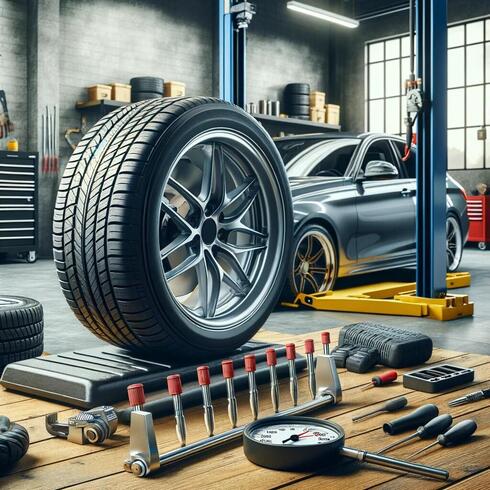
The Road Less Traveled: Signs It's Time to Replace Your Tires
The Road Less Traveled: Signs It's Time to Replace Your Tires
Tires wear down over time, and knowing when to replace them is crucial for your safety and driving performance.
Few things are more unsettling on a road trip than a niggling worry about your tires. Even the most dependable tires have a finite lifespan, and in this article we’ll help you identify the subtle signs your tires may need to be retired, ensuring a safe, stress-free journey.
Decoding Signs of Wear
Here are the key indicators that your tires are yearning for retirement:
- Tread Depth Takes a Dive: This is the most critical factor. Tires have built-in tread wear indicators, often small rubber bars across the grooves. When the tread surface wears down to the level of these bars, it's time to replace the tires. The trusty penny trick can also help. Insert a penny head-down into the tread groove. If you see Lincoln's entire head, your tread depth is below the recommended 2/32 inches and needs immediate replacement.
- Uneven Wear Tells a Story: Uneven tread wear across the tire surface indicates alignment issues, improper inflation, or worn-out suspension components. While some minor unevenness can be addressed through alignment adjustments, significant wear patterns necessitate tire replacements to maintain safe handling.
- Visible Cracks and Bulges Signal Danger: Cracks in the sidewall or tread can be a sign of dry rot or aging. Bulges or lumps on the tire surface indicate internal damage or a potential separation between the tread and the steel belts. Both situations pose a safety hazard and warrant immediate replacement.
- Vibration: Do you feel a vibration in the steering wheel or throughout the vehicle as you drive? This can be caused by unbalanced tires, but it can also be a sign of tread separation or internal tire damage. It's crucial to have the vibration diagnosed by a professional, and worn-out tires might be the culprit.
- Tire Age: Even if your tires have decent tread depth and no visible damage, age takes a toll. Tires degrade over time, losing their flexibility and grip. Experts recommend replacing tires after six to ten years, regardless of tread depth.
The Repair Route: When Patching Up Makes Sense
While replacement is often the safest option, there are some situations where tire repair might be possible:
- Small Punctures: Small punctures caused by nails or screws can sometimes be repaired with a tire patch plug if they haven't damaged the sidewall or exceeded a certain size limit. However, this should only be done by a qualified tire professional to ensure the repair is safe and effective.
Understanding Tire Repair Kits: A DIY Fix or a Temporary Band-Aid?
Tire repair kits are readily available and offer a seemingly convenient solution for flat tires on the road. However, there are limitations to consider:
- Temporary Fix: Tire repair kits are meant for temporary fixes, not permanent solutions. They can get you to a tire shop safely but shouldn't be considered a long-term solution for damaged tires.
- Not for All Scenarios: These kits are typically designed for small punctures in the tread area. They won't work for sidewall damage, larger punctures, or worn-out tires.
- Safety Concerns: Improper repair with a kit can compromise tire integrity and lead to blowouts. If you're unsure about the extent of the damage, it's always best to err on the side of caution and seek professional help.
The Bottom Line: Safety First
When it comes to tires, it's always better to be safe than sorry. Don't ignore the warning signs. Replacing worn-out tires is an investment in your safety, the safety of your passengers, and the longevity of your vehicle. While a tire repair kit can be a handy emergency tool, prioritize professional evaluation and replacement when necessary.
Beyond the Basics: Maintaining Tire Health
Here are some additional tips to extend the lifespan of your tires:
- Regular Rotations and Inspections: Rotate your tires every 5,000 to 7,000 miles to ensure even wear. Maintain proper tire pressure as recommended in your car's owner's manual. Regularly inspect your tires for any signs of damage.
- Alignment Matters: Proper wheel alignment prevents uneven wear and optimizes handling.
- Avoid Overloading: Don't overload your vehicle beyond its weight capacity, as this can put excessive stress on the tires.
By following these guidelines and being attentive to the signs your tires are sending, you can ensure smooth, safe journeys for miles to come. Remember, your tires are the vital connection between you and the road. Treat them well, and they'll take you wherever you want to go.















